LP77
| General Landscape Description: Irrigated pasture on a flat plain. Original vegetation included Black Box (Eucalyptus largiflorens) and Lignum Bush (Muehlenbeckia cunninghamii) | |
| Mapped Soil Type: Catumnal Loam |
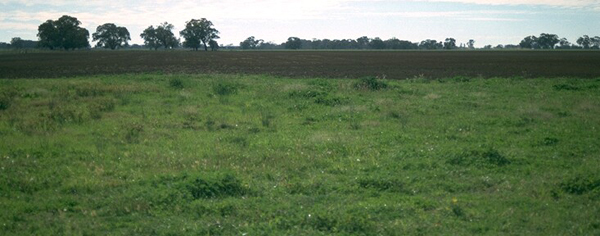 LP77 Landscape |
Soil Profile Morphology
Surface Soil
| A1 | 0-15 cm | Very dark greyish brown (10YR3/2); fine sandy light clay; hardsetting and cracking surface condition; moderate coarse blocky structure; very firm consistence moist; pH 7.4; abrupt and smooth change to: | 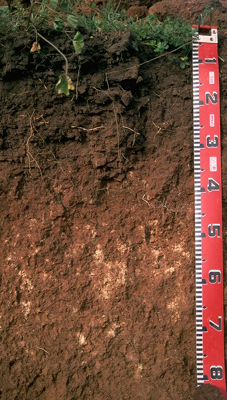 LP77 Profile |
| Subsoil | |||
| B21 | 15-30 cm | Reddish brown (5YR4/4); medium clay; strong coarse blocky structure; very firm consistence moist; pH 8.8; clear and wavy change to: | |
| B22 | 30-45 cm | Yellowish red (5YR5/8); medium clay; moderate coarse blocky structure (smooth faced peds); very strong consistence dry; contains very few (2%) soft carbonates; pH 9.4; clear and wavy change to: | |
| B23 | 45-75 cm | Yellowish red (5YR5/6); medium clay; moderate medium blocky, breaking down to strong fine blocky structure; very strong consistence dry; contains a few (10%) soft carbonates; pH 9.4; gradual change to: | |
| B24 | 75+ cm | Strong brown (7.5YR5/6); strong medium blocky, breaking down to moderate fine blocky structure; firm consistence dry; pH 9.2 | |
Key Profile Features
- Hardsetting and cracking surface condition.
- Accumulation of soft carbonate in the subsoil.
Key Profile Characteristics
pH | Salinity Rating | |||
Surface (A1 horizon) | slightly alkaline | low | non-sodic | none (strong) |
Subsoil (B21 horizon) | strongly alkaline | low | strongly sodic | complete |
Deeper subsoil (at 75+ cm) | very strongly alkaline | extremely high | very strongly sodic | __ |
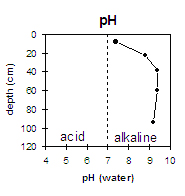 | 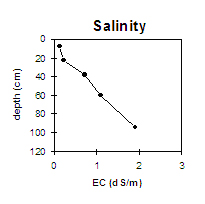 | 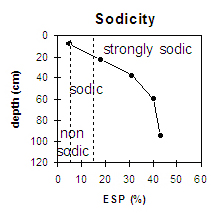 |
The surface is slightly alkaline. The subsoil is strongly alkaline becoming very strongly alkaline at 40 cm. | The salinity rating is low increasing gradually to an extremely high level at 75 cm. | The surface is non-sodic. The subsoil quickly becomes strongly sodic at 20 cm and extremely sodic at 30 cm. |
Management Considerations:
Whole Profile
- A very positive feature of this profile is that it has moderate inherent fertility in the surface and a high inherent fertility in the subsoil. This is very beneficial to plant growth.
Surface (A) Horizon
- The surface soil is hardsetting and cracking and has a high fine sand content (44%). When cultivated in a dry condition it will become ‘powdery’ and subsequent rainfall may result in surface sealing occurring. Soils such as these rely to a large extent on organic matter for maintaining aggregation. The levels of organic carbon measured at the pit site (which may or may not be representative of the whole paddock) is low. Organic matter levels will build up under pasture but will decline if cropping takes place. Practices such as residue retention, minimum tillage and including pasture rotations could be utilised if cropping takes place in order to build up organic matter, improve aggregation as well as assist in the low water holding capacity and reduce erosion risk.
- The surface soil is non-sodic with no dispersion. The presence of strong dispersion after remoulding indicates that structural degradation (e.g. surface sealing, increased cloddiness) may occur if the soil is cultivated or overstocked in a moist to wet condition. Also, raindrop action on bare surface soil may also promote dispersion and produce a hardsetting condition. Surface cover should be maintained to protect against raindrop damage.
Subsoil (B) Horizons
- The strongly alkaline subsoil becomes very strongly alkaline at 75 cm and this suggests that some nutrients (e.g. manganese, zinc, iron, copper) may be poorly available to plants. Nutrient deficiencies can be assessed by plant tissue analysis. Plant species which root deeper than 15 cm should be chosen in accordance with this pH level.
- The coarsely structured subsoil at 15 cm depth is strongly sodic becoming very strongly sodic at 60 cm with a low calcium to magnesium ration(0.4). As a result complete dispersion occurs restricting root and water movement. Deep ripping into the subsoil would help to break up the physical structural problems and the application of gypsum would help to neutralise the chemical sodic problems. This expensive option would firstly depend on expected crop yield and also on adequate rainfall, to wash the gypsum down the deep rips into the subsoil. Gypsum can also be added to the surface without deep ripping, but it would require more time to wash the gypsum down to the subsoil and less of it would probably make it.
- The salinity rating becomes extremely high at about 75 cm. These levels of soluble salts are likely to restrict the growth of deep rooted salt sensitive plant species (e.g. faba beans, linseed, chickpeas and lupins).
- The high level of exchangeable sodium and magnesium in the subsoil may also result in nutrient imbalances and may also have a toxic effect on some plants.
Notes:
Profile described by Mark Imhof, Sonia Thompson and Paul Rampant, May 1995.


